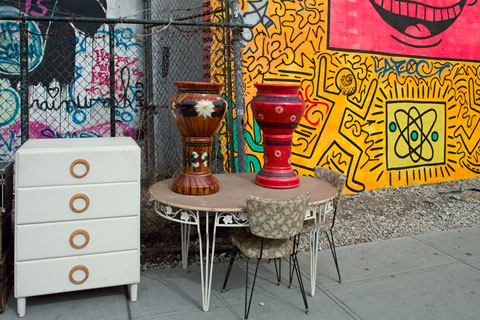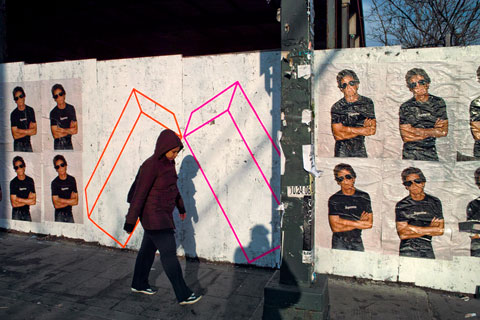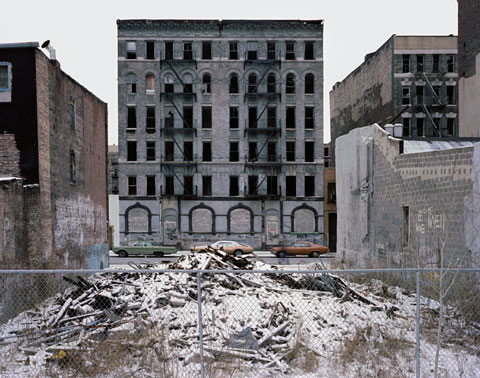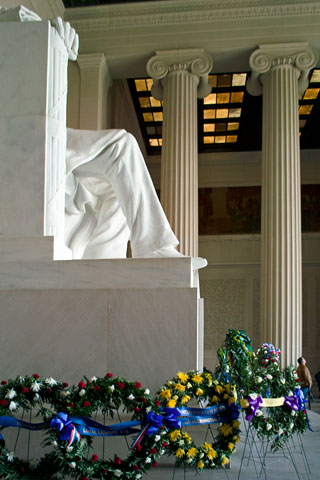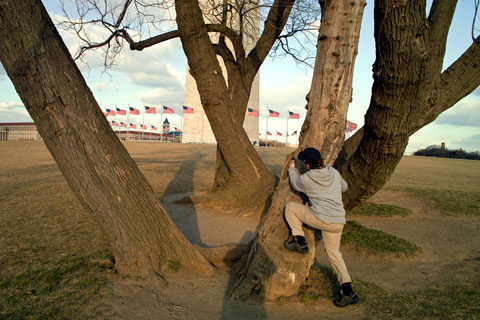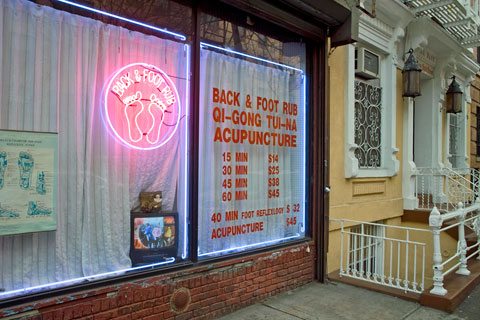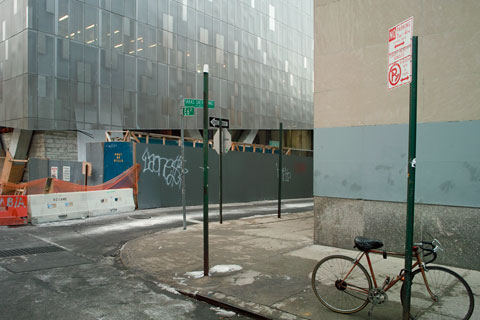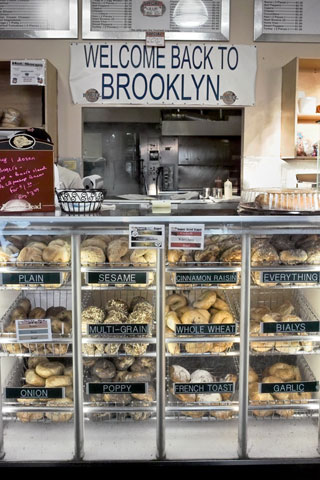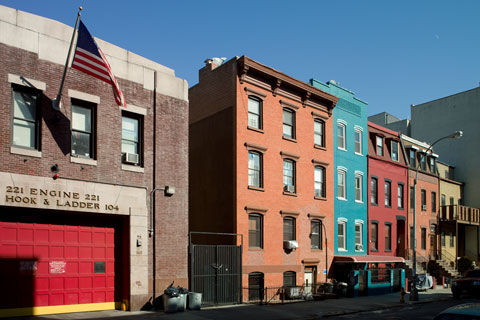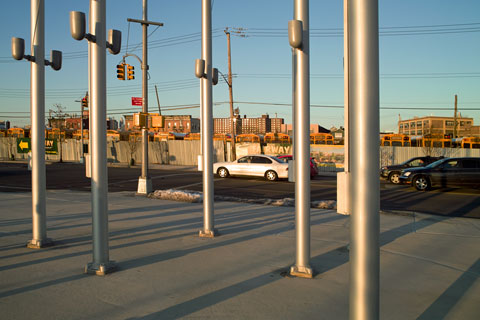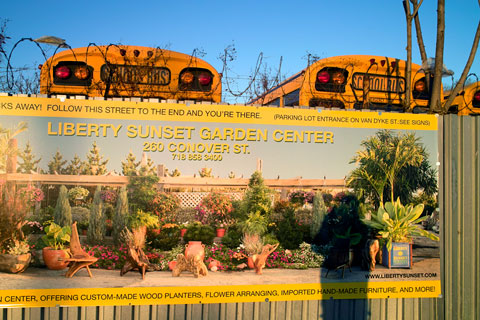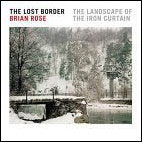Saturday, February 28, 2009
Thursday, February 26, 2009
Wednesday, February 25, 2009
Sunday, February 22, 2009
Williamsburg, Virginia/New York
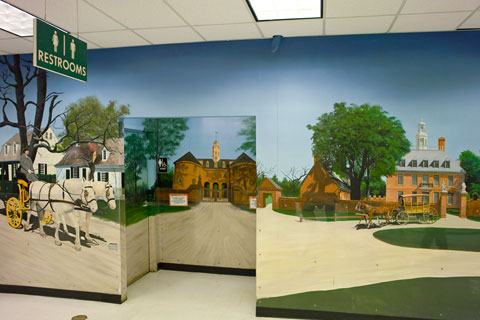
Williamsburg, Virginia -- © Brian Rose
Visited my father in Williamsburg, Virginia, still cruising along at 87, albeit in an assisted living residence. I did some shopping for him at the nearby Farm Fresh complete with local visual reference--in case one is overcome with that "lost in the supermarket" feeling.
Back in New York.
Saturday, February 21, 2009
Washington, D.C./Museum and Newseum
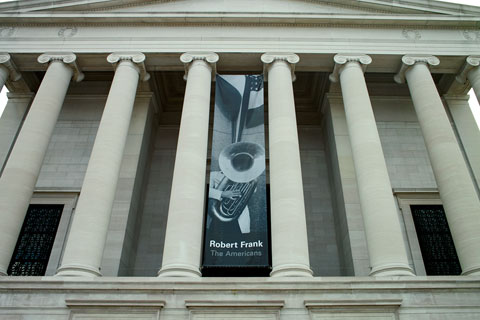
The National Gallery of Art and Robert Frank banner -- © Brian Rose
I managed to see two exhibits at the National Gallery of Art in the whirlwind visit to Washington, D.C. made with my 10 year old son Brendan--Robert Frank's the Americans and Pride of Place, Dutch Cityscapes of the Golden Age. I don't know which show to recommend more; they are both fabulous.
The first examines the making of Robert Frank's book The Americans, in my estimation the greatest of all photography books. Since The Americans deserves a more thorough review than I'm prepared to do now, I'll leave it for another time. It's worth going out of your way to visit D.C.to see it, but if you can't, the museum's website provides a nice taste. I've only glanced at the accompanying book, but will probably buy it the next time I'm at the Strand in New York.
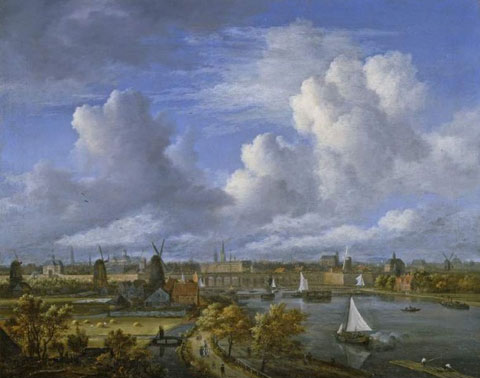
Jacob van Ruisdael, View on the Amstel looking towards Amsterdam
Cambridge, Fitzwilliam Museum
The second exhibition looks at the way in which cities and their surrounding landscapes were depicted by Dutch painters and mapmakers. Many of the paintings combine the sweep of the horizontal Dutch landscape punctuated by church spires and windmills with meticulous detail from foreground to background, at once expressing pride in civic achievement while taking note of ordinary citizens in city squares and at the threshhold between public and private life.
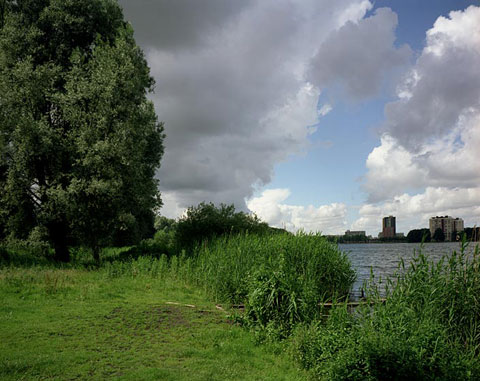
Sloterplas, Amsterdam -- © Brian Rose
These paintings always make me think of the way a view camera can be used to take in breadth and detail--and in that regard I have always found these Dutch paintings inspiring--something I have kept in mind, in particular, while photographing the periphery of Amsterdam.
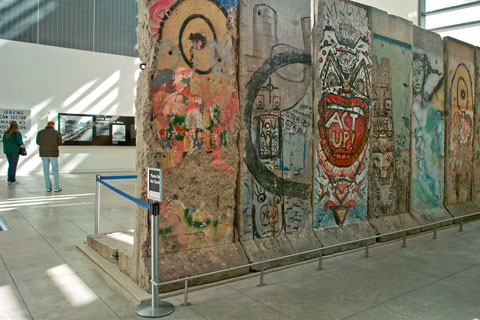
Berlin Wall exhibit at the Newseum -- © Brian Rose
For obvious reasons, I was especially interested in seeing the Berlin Wall exhibit at the Newseum, a new institution dedicated to the history of journalism and freedom of the press. It's located on Pennsylvania Avenue just across from the National Gallery. The Wall installation includes a number of original concrete sections placed next to each other to form a stretch of wall about 25 feet across. It looks incomplete to me, however, without the slotted pipe along the top, which was used to make climbing over more difficult. There is also an original guard tower, typical of those used in Berlin and elsewhere along the East/West German border rising up several stories in the exhibit space adjacent to the museum's glass elevators.
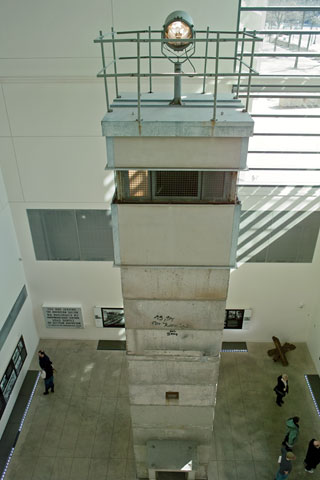
East German guard tower -- © Brian Rose
As is so often the case, the fact that fortifications extended most of the way across Europe is largely left out. Meaning that most people do not understand that Berlin was a separate enclave within East Germany surrounded by the Wall, and not part of the continuous line of fences and walls that ran along the East German, Czech, and Hungarian borders--with a heavily guarded Yugoslav border completing the partioning of Europe down to the Adriatic Sea.
That complaint aside, I am happy to see the Newseum give the Wall so much attention. It was the most potent symbol of the Cold War--and, in retrospect, hard to believe that such a thing could have existed. The Newseum is a pretty glitzy place full of multi-media and interactive displays, but my son loved it, and there was enough serious content to offset the fluff. I was also pleased to see a memorial to journalists killed in the line of their unique and important duty--reporting the news and disseminating the truth. Such a memorial deserves a place of honor on the Mall along with all the others.
Friday, February 20, 2009
Washington, D.C./World War II Memorial
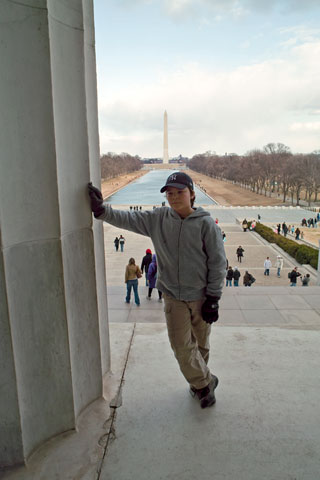
My son at the Lincoln Memorial -- © Brian Rose
Classicism is the dominant style of architecture in Washington, and any deviation from it is difficult to pull off--the Pei designed east wing of the National Gallery is, perhaps, the best effort. I like the sharp angles and the way it engages the triangle formed by Pennsylvania Avenue slicing across the grid.
The classicism of the Lincoln and Jefferson memorials as well as the design of the Capitol building express the early American idealism symbolized by Greek and Roman antecedents. The cool formality of classical design was meant to offer rationality and civilization in a largely undeveloped new world. That meaning remains clear and easy to decipher even today. The problem now in building on the Mall, is that reinterpreting classicism in a modern context often leads to unintended consequences.
I'd read the many critiques of the recently completed World War II memorial located just west of the Washington Monument, and while expecting the worst, I hoped that it would be less off putting seen in person. After all, there are plenty of less than inspiring buildings in Washington, and with few exceptions, we have learned to live with their mediocrity. (The Kennedy Center by Edward Durell Stone still rankles, however.)
So... I finally have seen the WWII memorial.
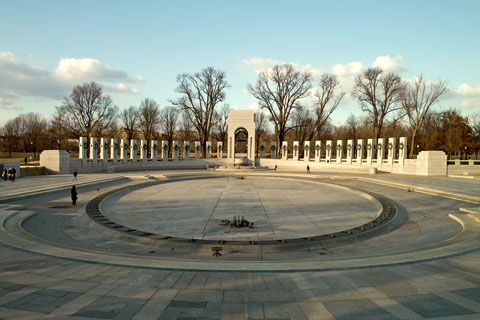
World War II Memorial -- © Brian Rose
Empty. Cold. That was my first reaction on this blustery President's day. The Lincoln Memorial and the Vietnam Memorial were filled with visitors--both have central focuses of attention. The Vietnam Memorial is a procession down along the wall of names and then up again on the other end. The Lincoln Memorial, of course, focuses on the seated statue inside the columned hall.
The WWII memorial is a multitude of elements: a fountain (vast stone oval in the winter), pillars, arches, wreaths, eagles, etched quotations, bas relief friezes, wall of stars, and more. All of these elements, rather than cohering into one statement seem to be a grab bag of features meant to satisfy the project commissioners and donors.
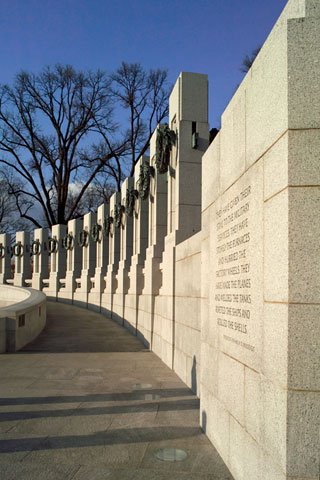
World War II memorial -- © Brian Rose
The unfortunate echoing of Nazi and Soviet architecture is unmistakable, and those who claim not to see it are either willfully oblivious or disingenuous. The architect, Friedrich St. Florian, and the leaders of the effort to build the memorial--Bob Dole most prominently-- ignored the howl of criticism directed at the design before it was built. They convinced themselves that what they were creating was dignified, heroic, and expressive of the ultimate victory achieved in the war.
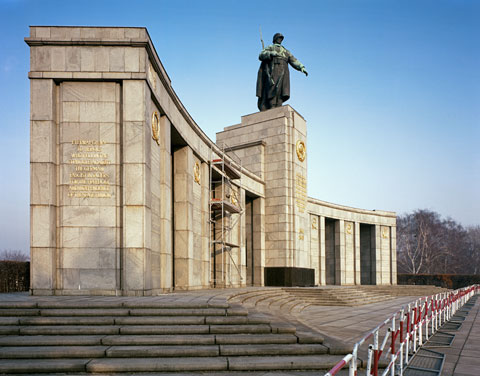
Soviet war memorial, Berlin -- © Brian Rose
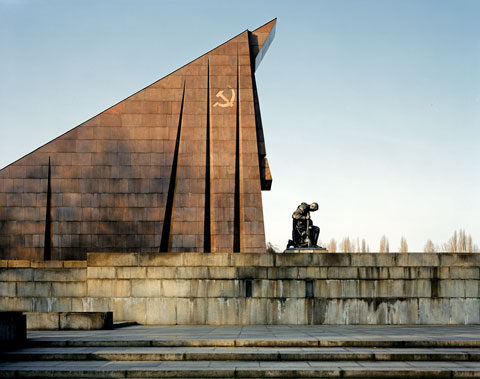
Soviet war memorial, Treptow Park, Berlin -- © Brian Rose
For sure, there are many people who defend the memorial in those terms, who are moved in the presence of it, but they neglect the sensibilities of the rest of us who cringe at the dissonance on display--making it difficult, if not impossible, to honor, remember, and pay our respects to those who died for country in World War II, the very purpose of the memorial.
The World War II memorial will undoubtedly persist as a jarring note on the Mall for decades to come. One can only hope that some future generation will have the courage to replace it with something more felicitous. For now, visit the beaches, the landscape, the cemeteries of Normandy where the connection to the war and to those who sacrificed their lives remains palpable to all.
Washington, D.C./Ben's Chili Bowl

Ben's Chili Bowl -- © Brian Rose
After a day of taking in museums and memorials along the Mall, we decided it was time for a little DC local flavor. I've always argued that Washington is a more interesting city than most people think once you get beyond the marble columns and vast expanses of public lawn.
So, up to 13th and U we headed to Ben's Chili Bowl, about a block from the spot I wrote/sang about in my song Open All Night. "There's news of a murder up a 14th and T/The waitress shivers with fright/As two cops tell a fish story/Open all night." Here's a recording of it.
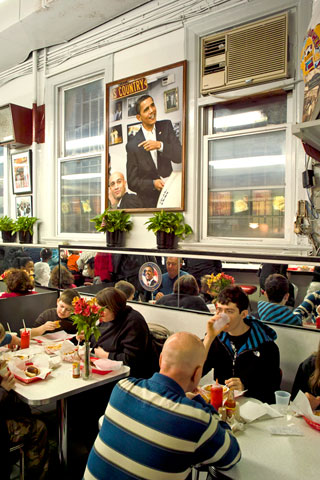
Ben's Chili Bowl -- © Brian Rose
Ben's is a diner specializing in cheap eats, namely half smokes slathered with chili, and other similar concoctions. It was there in the riots of 1968, and miraculously survived the rage that consumed and destroyed most of the businesses--many black-owned--that lined U Street. The area is now considerably gentrified, but still has its gritty aspects.
Ben's is on a roll these days especially since Barack Obama paid the joint a surprise visit on January 10th. And it was mobbed by visitors to the capitol during the inauguration festivities a few weeks ago. As we queued up in the alley next door to the restaurant, the line minder, keeping us in order in a friendly but firm sort of way, said that the place had been crazy crowded since the inauguration.
Don't think about your diet. Don't think about your last meal at a Michelin starred restaurant. Don't worry about your wallet in the midst of economic free fall--everything's under 10 bucks. Just grab your chili dog and fries--definitely get a milkshake--and soak in the fluourescent glow of Ben's Chili Bowl.
Monday, February 16, 2009
Saturday, February 14, 2009
New York/Paul Graham
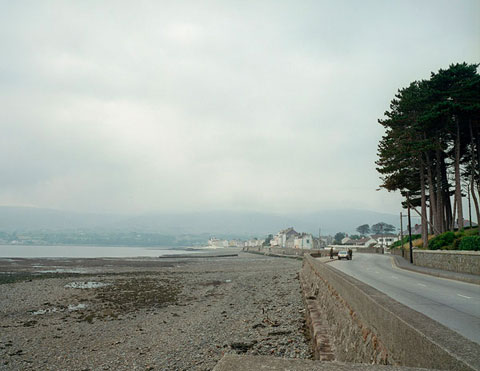
Photograph by Paul Graham from Troubled Land
Back when I was beginning to photograph the former Iron Curtain, I came across Paul Graham's book Troubled Land, which dealt with the conflict in Northern Ireland. I was struck by the way he approached the issue as a landscape photographer, his pictures noting the small bits of evidence of the ongoing strife rather than confronting the action head on as so many photojournalists had. The picture above, for instance, shows a highway checkpoint from a distance. I felt a kinship there with the way I was looking at the landscape of the east/west border.
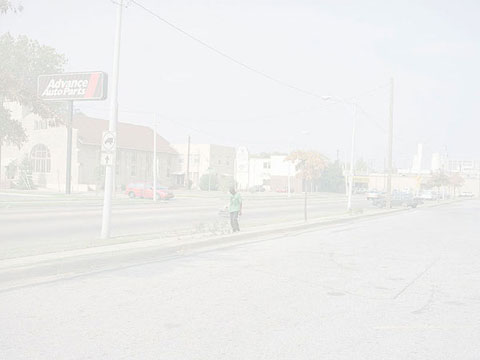
Photograph by Paul Graham from American Night
It's been years since I've seen much of Graham's work, although I knew that he had taken on other projects. I saw his American Night work, which I had mixed feelings about, the high key, blown out, images of figures walking or standing in neglected neighborhoods, juxtaposed with normally printed views of comfortable suburban homes. It seemed a little forced to me. But I've always appreciated Graham's social engagement, even as his work clearly distances itself from the "concerned photographer" kind of documentary or journalistic photography. He is on the same turf as Walker Evans and Robert Adams on the big camera side of the equation, and Robert Frank and Michael Schmidt on the small camera side. Graham, of course, works in color, starting in the early 80s, and would have to be considered an early practitioner of that medium.
In recent years he has been working in image multiples or series. Not in the conceptual sense of serial photography, although it is obvious that he has thought a lot about contemporary photography and current trends. So, with his newest work now showing at the Modern--A Shimmer of Possibility--Graham has moved beyond the traditional "one off" approach of most street photography, that moments are defined strictly in terms of 1/125 second slivers of time. Graham is looking at situations, or short passages of time. Not a lot of action happens in these bits of real life Graham is attentive to, but they are as much about lassitude as anything else.
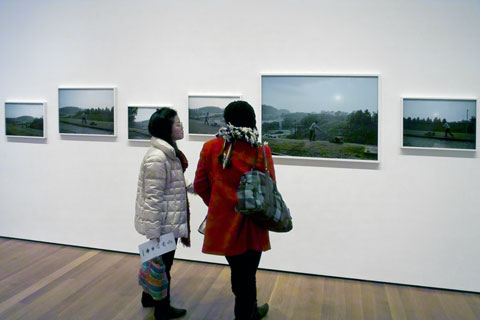
Paul Graham at the Museum of Modern Art -- © Brian Rose
A man mows a lawn moving left and then right in the fading daylight. His van stands alone in the nearby parking lot--waiting. A man stands in a back alley smoking a cigarette. A woman eats a meal while seated at a bus stop. Graham records the woman and then looks down at debris on the sidewalk. These cinematic moments are like loops, a series of jump cuts, but something that would be hard to make arresting in film or video. It would all happen too fast without the considered apprehension that is the domain of still photography.

Paul Graham at the Museum of Modern Art -- © Brian Rose
Most of the people in these photo suites are working class or underclass, often African-American. Many are seen in marginalized areas of the cityscape--alleys, parking lots, narrow sidewalks around strip malls, etc. Many are seen walking in places where more prosperous people would be driving. Many seem lost to their own thoughts as they attend to one chore or another--or are just waiting.
A few days after I visited Graham's exhibit at the Modern I heard him speak at the SVA theater on 23rd Street. I was a little late getting there, and was surprised to be greeted by an overflowing hall of more than 200 people. I ended up on a metal folding chair parked off to the side of the stage. But he and moderator Philip Gefter just talked anyway--only a few photographs were shown. It was satisfying, if not inspiring, to hear him defend the continuing role of photography to observe the world around us--as opposed to the "synthetic" world that is particulary in vogue in the Chelsea galleries.
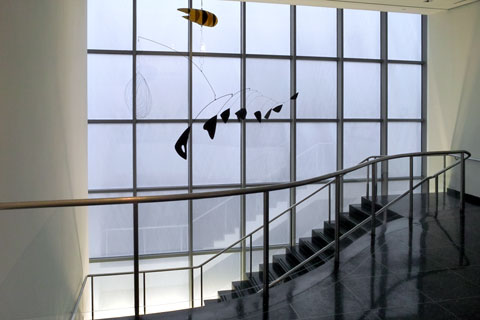
Museum of Modern Art stairs -- © Brian Rose
I said hello at the end of the evening, and mentioned that I had a book out there called the Lost Border--a project spanning 19 years of history. He'd never heard of it, or me, which shows how far out of the mainstream I still am.
Sunday, February 08, 2009
New York/LES
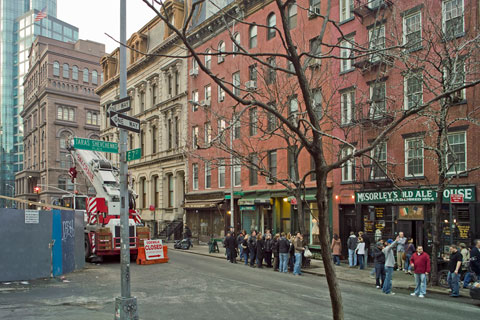
East 7th Street, Mcsorley's -- © Brian Rose (digital camera)
After a sub-freezing week featuring several inches of snow, today warmed up well into the 40s. I went out with the view camera near the end of the day and took one photograph as the light began to fall. I did several versions similar to the view above.
This scene in front of McSorley's Ale House has been repeating itself on weekends for years. McSorley's is very old, famous bar, but ultimately just a bar. Nevertheless, out-of-towners--one presumes--line up to be admitted into the hallowed taproom.
To the rear is the new apartment tower on Astor Place, the brownstone Cooper Union building, and the construction is related to a new Cooper building just out of sight to the left. I'll have more on that later.
